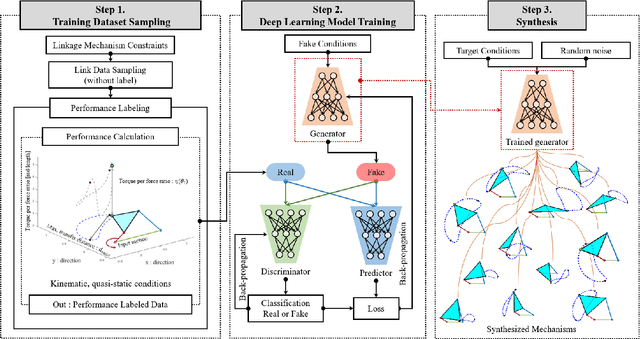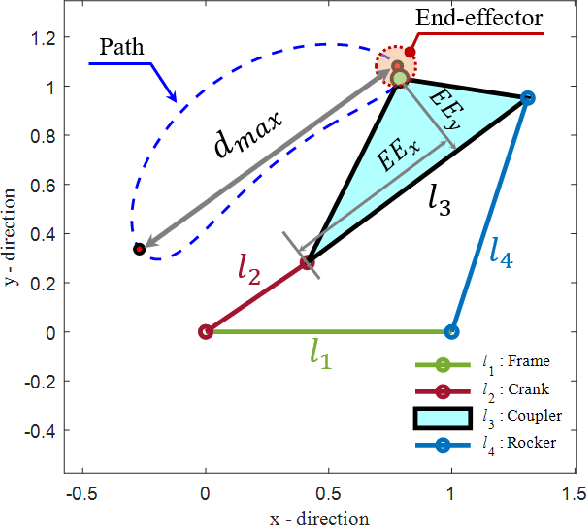Sumin Lee
Korea Advanced Institute of Science and Technology
Geometric Embedding Alignment via Curvature Matching in Transfer Learning
Jun 16, 2025Abstract:Geometrical interpretations of deep learning models offer insightful perspectives into their underlying mathematical structures. In this work, we introduce a novel approach that leverages differential geometry, particularly concepts from Riemannian geometry, to integrate multiple models into a unified transfer learning framework. By aligning the Ricci curvature of latent space of individual models, we construct an interrelated architecture, namely Geometric Embedding Alignment via cuRvature matching in transfer learning (GEAR), which ensures comprehensive geometric representation across datapoints. This framework enables the effective aggregation of knowledge from diverse sources, thereby improving performance on target tasks. We evaluate our model on 23 molecular task pairs sourced from various domains and demonstrate significant performance gains over existing benchmark model under both random (14.4%) and scaffold (8.3%) data splits.
Trajectory-Class-Aware Multi-Agent Reinforcement Learning
Mar 03, 2025Abstract:In the context of multi-agent reinforcement learning, generalization is a challenge to solve various tasks that may require different joint policies or coordination without relying on policies specialized for each task. We refer to this type of problem as a multi-task, and we train agents to be versatile in this multi-task setting through a single training process. To address this challenge, we introduce TRajectory-class-Aware Multi-Agent reinforcement learning (TRAMA). In TRAMA, agents recognize a task type by identifying the class of trajectories they are experiencing through partial observations, and the agents use this trajectory awareness or prediction as additional information for action policy. To this end, we introduce three primary objectives in TRAMA: (a) constructing a quantized latent space to generate trajectory embeddings that reflect key similarities among them; (b) conducting trajectory clustering using these trajectory embeddings; and (c) building a trajectory-class-aware policy. Specifically for (c), we introduce a trajectory-class predictor that performs agent-wise predictions on the trajectory class; and we design a trajectory-class representation model for each trajectory class. Each agent takes actions based on this trajectory-class representation along with its partial observation for task-aware execution. The proposed method is evaluated on various tasks, including multi-task problems built upon StarCraft II. Empirical results show further performance improvements over state-of-the-art baselines.
Vehicle Suspension Recommendation System: Multi-Fidelity Neural Network-based Mechanism Design Optimization
Oct 03, 2024



Abstract:Mechanisms are designed to perform functions in various fields. Often, there is no unique mechanism that performs a well-defined function. For example, vehicle suspensions are designed to improve driving performance and ride comfort, but different types are available depending on the environment. This variability in design makes performance comparison difficult. Additionally, the traditional design process is multi-step, gradually reducing the number of design candidates while performing costly analyses to meet target performance. Recently, AI models have been used to reduce the computational cost of FEA. However, there are limitations in data availability and different analysis environments, especially when transitioning from low-fidelity to high-fidelity analysis. In this paper, we propose a multi-fidelity design framework aimed at recommending optimal types and designs of mechanical mechanisms. As an application, vehicle suspension systems were selected, and several types were defined. For each type, mechanism parameters were generated and converted into 3D CAD models, followed by low-fidelity rigid body dynamic analysis under driving conditions. To effectively build a deep learning-based multi-fidelity surrogate model, the results of the low-fidelity analysis were analyzed using DBSCAN and sampled at 5% for high-cost flexible body dynamic analysis. After training the multi-fidelity model, a multi-objective optimization problem was formulated for the performance metrics of each suspension type. Finally, we recommend the optimal type and design based on the input to optimize ride comfort-related performance metrics. To validate the proposed methodology, we extracted basic design rules of Pareto solutions using data mining techniques. We also verified the effectiveness and applicability by comparing the results with those obtained from a conventional deep learning-based design process.
Scalable Multi-Task Transfer Learning for Molecular Property Prediction
Oct 01, 2024



Abstract:Molecules have a number of distinct properties whose importance and application vary. Often, in reality, labels for some properties are hard to achieve despite their practical importance. A common solution to such data scarcity is to use models of good generalization with transfer learning. This involves domain experts for designing source and target tasks whose features are shared. However, this approach has limitations: i). Difficulty in accurate design of source-target task pairs due to the large number of tasks, and ii). corresponding computational burden verifying many trials and errors of transfer learning design, thereby iii). constraining the potential of foundation modeling of multi-task molecular property prediction. We address the limitations of the manual design of transfer learning via data-driven bi-level optimization. The proposed method enables scalable multi-task transfer learning for molecular property prediction by automatically obtaining the optimal transfer ratios. Empirically, the proposed method improved the prediction performance of 40 molecular properties and accelerated training convergence.
Task Addition in Multi-Task Learning by Geometrical Alignment
Sep 25, 2024



Abstract:Training deep learning models on limited data while maintaining generalization is one of the fundamental challenges in molecular property prediction. One effective solution is transferring knowledge extracted from abundant datasets to those with scarce data. Recently, a novel algorithm called Geometrically Aligned Transfer Encoder (GATE) has been introduced, which uses soft parameter sharing by aligning the geometrical shapes of task-specific latent spaces. However, GATE faces limitations in scaling to multiple tasks due to computational costs. In this study, we propose a task addition approach for GATE to improve performance on target tasks with limited data while minimizing computational complexity. It is achieved through supervised multi-task pre-training on a large dataset, followed by the addition and training of task-specific modules for each target task. Our experiments demonstrate the superior performance of the task addition strategy for GATE over conventional multi-task methods, with comparable computational costs.
Flow-Assisted Motion Learning Network for Weakly-Supervised Group Activity Recognition
May 28, 2024



Abstract:Weakly-Supervised Group Activity Recognition (WSGAR) aims to understand the activity performed together by a group of individuals with the video-level label and without actor-level labels. We propose Flow-Assisted Motion Learning Network (Flaming-Net) for WSGAR, which consists of the motion-aware actor encoder to extract actor features and the two-pathways relation module to infer the interaction among actors and their activity. Flaming-Net leverages an additional optical flow modality in the training stage to enhance its motion awareness when finding locally active actors. The first pathway of the relation module, the actor-centric path, initially captures the temporal dynamics of individual actors and then constructs inter-actor relationships. In parallel, the group-centric path starts by building spatial connections between actors within the same timeframe and then captures simultaneous spatio-temporal dynamics among them. We demonstrate that Flaming-Net achieves new state-of-the-art WSGAR results on two benchmarks, including a 2.8%p higher MPCA score on the NBA dataset. Importantly, we use the optical flow modality only for training and not for inference.
Multitask Extension of Geometrically Aligned Transfer Encoder
May 03, 2024



Abstract:Molecular datasets often suffer from a lack of data. It is well-known that gathering data is difficult due to the complexity of experimentation or simulation involved. Here, we leverage mutual information across different tasks in molecular data to address this issue. We extend an algorithm that utilizes the geometric characteristics of the encoding space, known as the Geometrically Aligned Transfer Encoder (GATE), to a multi-task setup. Thus, we connect multiple molecular tasks by aligning the curved coordinates onto locally flat coordinates, ensuring the flow of information from source tasks to support performance on target data.
Spatio-Temporal Proximity-Aware Dual-Path Model for Panoramic Activity Recognition
Mar 21, 2024Abstract:Panoramic Activity Recognition (PAR) seeks to identify diverse human activities across different scales, from individual actions to social group and global activities in crowded panoramic scenes. PAR presents two major challenges: 1) recognizing the nuanced interactions among numerous individuals and 2) understanding multi-granular human activities. To address these, we propose Social Proximity-aware Dual-Path Network (SPDP-Net) based on two key design principles. First, while previous works often focus on spatial distance among individuals within an image, we argue to consider the spatio-temporal proximity. It is crucial for individual relation encoding to correctly understand social dynamics. Secondly, deviating from existing hierarchical approaches (individual-to-social-to-global activity), we introduce a dual-path architecture for multi-granular activity recognition. This architecture comprises individual-to-global and individual-to-social paths, mutually reinforcing each other's task with global-local context through multiple layers. Through extensive experiments, we validate the effectiveness of the spatio-temporal proximity among individuals and the dual-path architecture in PAR. Furthermore, SPDP-Net achieves new state-of-the-art performance with 46.5\% of overall F1 score on JRDB-PAR dataset.
Deep Generative Model-based Synthesis of Four-bar Linkage Mechanisms with Target Conditions
Feb 22, 2024



Abstract:Mechanisms are essential components designed to perform specific tasks in various mechanical systems. However, designing a mechanism that satisfies certain kinematic or quasi-static requirements is a challenging task. The kinematic requirements may include the workspace of a mechanism, while the quasi-static requirements of a mechanism may include its torque transmission, which refers to the ability of the mechanism to transfer power and torque effectively. In this paper, we propose a deep learning-based generative model for generating multiple crank-rocker four-bar linkage mechanisms that satisfy both the kinematic and quasi-static requirements aforementioned. The proposed model is based on a conditional generative adversarial network (cGAN) with modifications for mechanism synthesis, which is trained to learn the relationship between the requirements of a mechanism with respect to linkage lengths. The results demonstrate that the proposed model successfully generates multiple distinct mechanisms that satisfy specific kinematic and quasi-static requirements. To evaluate the novelty of our approach, we provide a comparison of the samples synthesized by the proposed cGAN, traditional cVAE and NSGA-II. Our approach has several advantages over traditional design methods. It enables designers to efficiently generate multiple diverse and feasible design candidates while exploring a large design space. Also, the proposed model considers both the kinematic and quasi-static requirements, which can lead to more efficient and effective mechanisms for real-world use, making it a promising tool for linkage mechanism design.
Modality Mixer Exploiting Complementary Information for Multi-modal Action Recognition
Nov 21, 2023Abstract:Due to the distinctive characteristics of sensors, each modality exhibits unique physical properties. For this reason, in the context of multi-modal action recognition, it is important to consider not only the overall action content but also the complementary nature of different modalities. In this paper, we propose a novel network, named Modality Mixer (M-Mixer) network, which effectively leverages and incorporates the complementary information across modalities with the temporal context of actions for action recognition. A key component of our proposed M-Mixer is the Multi-modal Contextualization Unit (MCU), a simple yet effective recurrent unit. Our MCU is responsible for temporally encoding a sequence of one modality (e.g., RGB) with action content features of other modalities (e.g., depth and infrared modalities). This process encourages M-Mixer network to exploit global action content and also to supplement complementary information of other modalities. Furthermore, to extract appropriate complementary information regarding to the given modality settings, we introduce a new module, named Complementary Feature Extraction Module (CFEM). CFEM incorporates sepearte learnable query embeddings for each modality, which guide CFEM to extract complementary information and global action content from the other modalities. As a result, our proposed method outperforms state-of-the-art methods on NTU RGB+D 60, NTU RGB+D 120, and NW-UCLA datasets. Moreover, through comprehensive ablation studies, we further validate the effectiveness of our proposed method.
 Add to Chrome
Add to Chrome Add to Firefox
Add to Firefox Add to Edge
Add to Edge